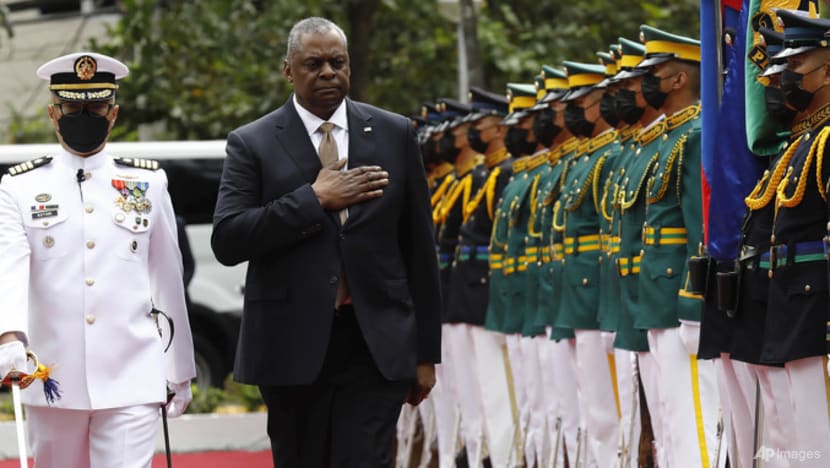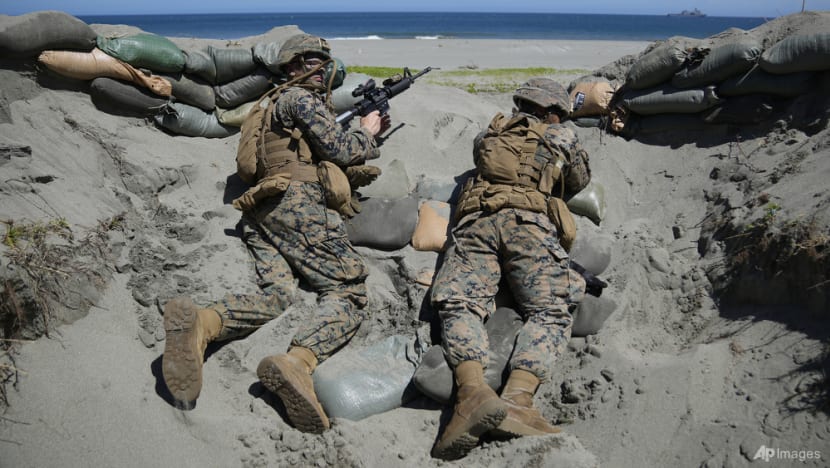Philippines military bases ‘strategic real estate’ for US near Taiwan: Analysts
The agreement between the Philippines and US aims to bolster defence commitments amid mounting concerns over China’s activities in the area, observers said.

U.S. Defense Secretary Lloyd Austin (2nd L) walks past military guards during his arrival at the Department of National Defense in Camp Aguinaldo military camp in Quezon City, Metro Manila, Philippines February 2, 2023. (AP/Rolex Dela Pena)
Securing access to military bases in the Philippines will give the United States a greater “strategic real estate” in the South China Sea, significantly boosting its presence and security options closer to Taiwan, analysts said.
Before the deal on Thursday (Feb 2), the US forces relied on access to the region through Japan, South Korea, and Singapore, with “nothing guaranteed in between”, analyst Euan Graham told CNA’s Asia Now.
The Philippines had been the missing link placing the US right in the middle of two “flash points” – the South China Sea and Taiwan – “with options to bring its defence forces into these strategically significant areas,” he said.
“To put it simply, the Philippines is a very important strategic real estate,” said Dr Graham, a Shangri-La Dialogue senior fellow for Indo-Pacific Defence and Strategy at think tank International Institute for Strategic Studies (IISS).
The newly-announced agreement will provide the US access to four additional locations in the Philippines.
The pact aims to bolster defence commitments between the two nations amid mounting concerns over China’s activities in the area, observers said.
TAIWAN AND THE LUZON STRAIT
One key area of concern in the region is the Luzon Strait, a waterway north of the Philippines separating the nation’s largest and most populous island of Luzon, and Taiwan.
Following former US House Speaker Nancy Pelosi’s visit to Taiwan in August last year, Beijing retaliated by launching extended, large-scale military exercises around the island – a response closely watched by Manila.
“During those exercises, it was very clear and revealing to observers that in the event that China invades Taiwan, Beijing would stand to control the Luzon Strait, a very crucial waterway,” said Mr Ridzwan Rahmat, a principal defence analyst at open source intelligence firm Janes.
For Washington, it is important to maintain control over the strait to ensure that US forces will have unimpeded access to Taiwan in the event of a war with China, he added.
Mr Ridzwan said he believes this is the key reason behind US Defense Secretary Lloyd Austin’s visit to the Philippines this week, as securing bases for a US presence can deny China the ability to exert its forces over the waterway.
The deal, which will see the US pump in US$82 million for infrastructure investments at existing sites, is “very significant” as this is Washington’s first expansion of defence access in Southeast Asia in recent years, said Dr Graham.
The agreement will make it easier for US forces to operate in the region, by allowing access for joint training, building of facilities, and storing of equipment and supplies.
While defence chiefs from both countries did not state the locations of the bases, Dr Graham said that plans for military exercises later this year hint at a build-up in presence in the north of Luzon.
MANILA’S BALANCING ACT
Experts said Manila now threads a delicate line between the US and China, as Beijing will likely be infuriated by Thursday’s deal.

China already sees itself being strategically encircled by US military forces from Guam, the Misawa Air Base and Yokosuka Naval Base in Japan, and the Kunsan Air Base in South Korea, said Mr Ridzwan.
“With these additional military bases in the Philippines, I think the Chinese are going to see this as a tightening of the American military noose around the region, and I imagine there will be certain policy shifts in Beijing's planning doctrines in the months to come,” he added.
Philippine President Ferdinand Marcos Jr’s geopolitical view is a departure from former president Rodrigo Duterte, whose foreign policy distanced the country from the US and gravitated towards China.
With Mr Marcos’ recent return from his state visit to China, where he snagged billions in investment pledges, Dr Graham said that observers may be surprised by the Philippines’ attachment to the US in terms of securing itself against potential threats.
“(But) this is not a departure from China relations for the Philippines … It's part of Manila’s balancing strategy,” he said.
Related:
Mr Ridzwan said this was merely a “reset” of Manila’s foreign policy, which has for decades fostered close relations with Washington, given the Philippines' limited defence capability.
“People in the Philippines still very much support the US military’s presence in the region, especially in the wake of what took place in the South China Sea in the last few years,” said Mr Ridzwan.
The Philippines has repeatedly clashed with China over activities in the South China Sea, including Beijing’s claims of sovereignty over much of the area’s islands and waters.
“The public perception is still that the US will defend the Philippines should they get into a conflict with China,” Mr Ridzwan said.
Apart from the US, the Philippines is also looking to strengthen bilateral defence relations with Japan. Mr Marcos is scheduled to travel to Tokyo next week to discuss proposed security agreements between the two nations.
















